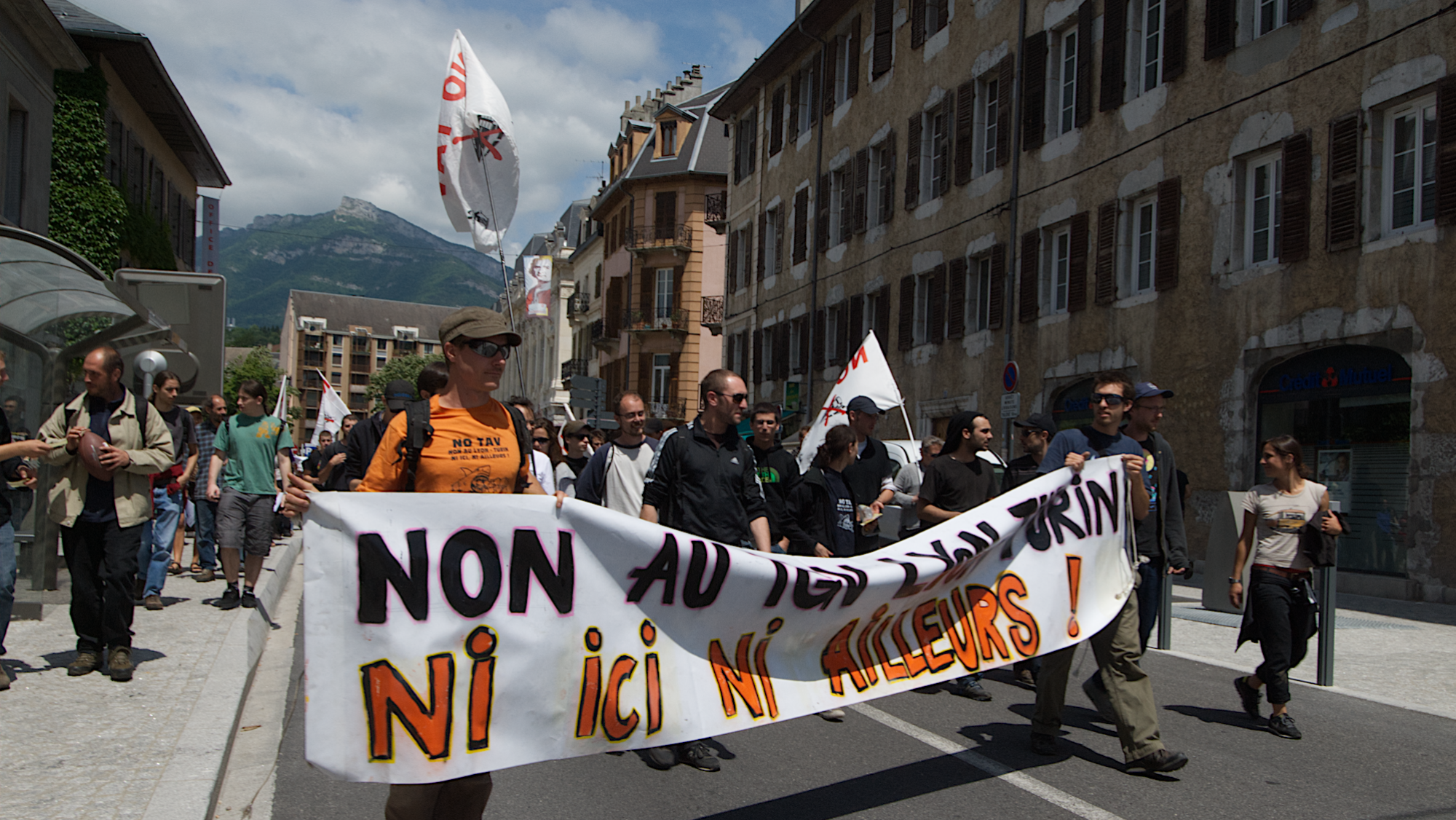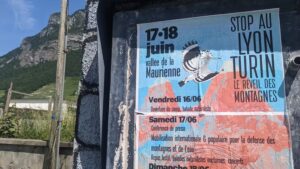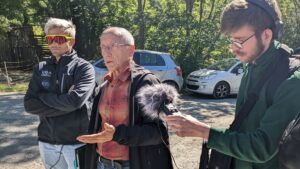Publications
Lyon-Turin : serpent de mer et terrain d’investigation pour les chercheurs
 © Leïla Shahshahani
© Leïla Shahshahani
Le projet d’une nouvelle liaison ferroviaire entre Lyon et Turin, imaginée au début des années quatre-vingt-dix, intéresse de près les chercheurs en sciences humaines et sociales, au gré des contestations qui rythment son déploiement.

A la veille d’un week-end de mobilisation franco-italienne prévu en Maurienne les 17 et 18 juin prochains, Mikaël Chambru – co-coordinateur scientifique du Labex ITTEM – retrace la genèse de l’opposition française au projet pour The Conversation. Chercheur au sein du Groupe de recherche sur les enjeux de la communication (Gresec) à l’Université Grenoble Alpes (UGA), il s’intéresse aux controverses publiques et mobilisations socio-environnementales en montagne, illustration des divergences sur les visions et attentes en matière de transition écologique et sociale.
A propos de cette nouvelle ligne ferroviaire, il résume : « Pour ses promoteurs, elle est présentée comme une infrastructure de transport utile à la transition écologique. Selon eux, elle permettrait à terme de désengorger les vallées alpines du trafic des poids lourds en favorisant le report modal de la route vers le rail. À l’inverse, ce projet est exposé par ses opposants comme pharaonique, inutile et destructeur de l’environnement. Ils argumentent que la ligne ferroviaire existante entre Lyon et Turin et actuellement sous-utilisée permettrait, une fois rénovée, de réduire le transport de fret par camion. »
 Mikaël Chambru a également animé un atelier pédagogique sur la question des controverses autour du Lyon-Turin avec les étudiants du Master CCST de l’UGA. Basé à Aussois en Maurienne, il a donné lieu à plusieurs formes de médiation : un stream sur Twitch, une restitution publique, des ateliers de médiation scientifique auprès d’élèves d’un collège de Chambéry et la réalisation de podcasts.
Mikaël Chambru a également animé un atelier pédagogique sur la question des controverses autour du Lyon-Turin avec les étudiants du Master CCST de l’UGA. Basé à Aussois en Maurienne, il a donné lieu à plusieurs formes de médiation : un stream sur Twitch, une restitution publique, des ateliers de médiation scientifique auprès d’élèves d’un collège de Chambéry et la réalisation de podcasts.
Les géographes se penchent aussi sur le cas du Lyon-Turin. Kevin Sutton, chercheur au laboratoire Pacte (UGA), écrivait dans la Revue de géographie alpine en 2016 : « Contestations française et italienne connaissent des genèses différentes. La territorialité alternative promue par le mouvement No TAV n’est pas transposable, alors même qu’elle en constitue la force et la singularité (…) L’absence de référentiel alpin côté français se comprend par l’histoire d’une contestation essentiellement née dans des avant-pays périurbains (…) Tant Chimilin que Chapareillan se situent dans des entre-deux dont l’identité n’est pas associée à une dimension « montagne », mais « rurale » et « agricole ». Dans le Val de Suse, ces trois aspects se fondent en une identité de la vallée, soit un référentiel alpin montagnard. L’argument paysager de la contestation s’entend côté italien dans une forme d’habiter une idée de la montagne, alors que côté français il est plus question de valorisation foncière.»
Associé au projet de recherche Telimep – Dynamiques de transformation et de perception des territoires de montagne – porté au sein du Labex ITTEM, Kevin Sutton a contribué à l’ouvrage Montagne et liminalité, les manifestations alpines de l’entre-deux XVIe- XXIe siècles (éd. PUG/UGA), explorant les notions de limites, de circulations, de conflictualités et d’identités en montagne. Les géographes Kirsten Koop et Pierre-Antoine Landel (Pacte) y signent un chapitre : « (…) Le TAV risque de reléguer la vallée de Suse au statut de marge entre les pôles dynamiques et mondialisés. Dans ce contexte, l’émergence d’un nouvel imaginaire, d’une nouvelle identité territoriale dans le sillage de cette lutte politique produit une nouvelle territorialité (…) ». Le regard des historiens y est également convoqué. « Des barricades sous le Duc de Savoie jusqu’aux blocages des tunnels par les associations mobilisées contre le projet Lyon-Turin (TAV), la morphologie montagnarde favorise la fermeture des circulations et ainsi la résistance face à la conquête politique ou la normalisation économique », écrit Stéphane Gal (Larhra) dans son introduction co-écrite avec Marie-Christine Fourny (Pacte), avec qui il a dirigé l’ouvrage.
C’est aussi une perspective historique que propose Anne-Marie Granet (Larhra) dans son article L’aplanissement de la montagne : un rêve de techniciens et d’aménageurs européens paru dans la revue Histoire des Alpes, éditée par l’Association internationale pour l’Histoire des Alpes en 2016 : « Dans cette histoire longue de la circulation, des passages et des frontières – naturelles ou étatiques -, les grands chantiers prévus et en cours à l’échelle européenne transforment radicalement le rapport au territoire, puisqu’il s’agit de créer au sein de l’arc alpin, des passages permettant des flux massifs et rapides (…). Dernier parmi les très grands chantiers européens, il (ndlr : le projet Lyon-Turin) est un des exemples les plus récents de ces aménagements à l’ambition technique, financière et politique gigantesque qui reprend le rêve de déplacements faciles et rapides, sans risques et pour les Alpes, sans interruption en période hivernale. (…) Pour l’historien des Alpes, c’est aborder le devenir de ces territoires à un moment important de leur reconfiguration au sein de l’espace européen sans négliger les questions des frontières. »
À deux jours de la mobilisation prévue en Savoie contre le projet Lyon-Turin, les associations Cipra France et Mountain Wilderness publient un communiqué le 15 juin 2023 dans lequel elles affirment qu’« il est l’heure de repenser de manière globale et cohérente nos mobilités. Il est ni possible ni enviable de construire des infrastructures toujours plus grosses. Cela va à l’encontre de l’objectif de la Convention Alpine qui est justement de limiter ces infrastructures afin de préserver les Alpes qui sont avant tout une source de vie et non un canal de transport.»
Avec la perspective de construction de nouvelles voies d’accès au tunnel transfrontalier repoussées à 2045, nul doute que cette controverse continuera d’alimenter le travail des chercheuses et chercheurs de toutes disciplines.
